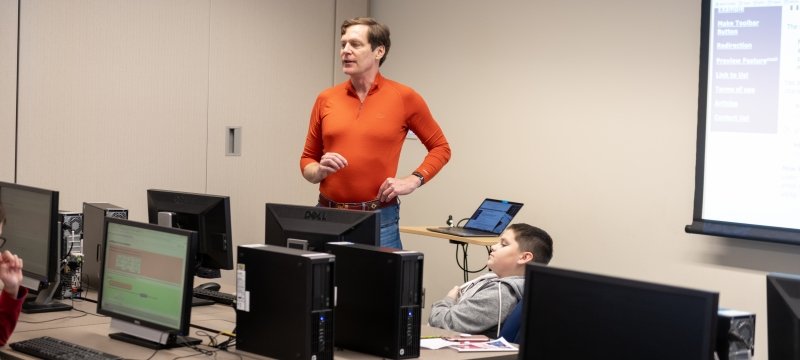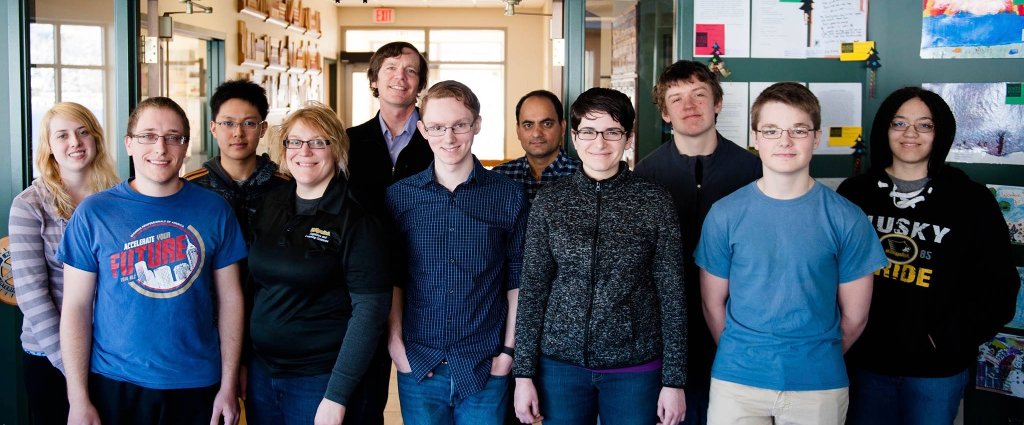Essays by members of Michigan Tech's Institute for Policy, Ethics, and Culture from the 1,000 Words Project "SARS-CoV-2: What Kind of Crisis is This?" offer perspectives on pandemic culture.
Charles Wallace is associate professor of computer science and associate dean for curriculum and instruction. He co-leads the Building Adult Skills in Computing (BASIC) community program and is co-advisor for the student-led Copper Country Coders.
“What do you see on the screen?”
“I see…I don’t know what I see.”
It’s a Saturday morning in April, and the BASIC (Building Adult Skills in Computing) program is back, in an all-online format due to COVID-19. Kathy has phoned in from one of the historic mining towns up north in Michigan’s Keweenaw Peninsula, and I’m talking her through how to get her iPad online. Her daughter downstate gave her the tablet some time ago, hoping that telemedicine could replace her frequent and onerous drives to the hospital. Now the pandemic has made that option a necessity.
About the Researcher
The BASIC tutors have scored several successes this Saturday. Community members with various levels of digital experience have contacted us, and in the wake of the statewide lockdown, the focus has naturally been on videoconferencing. We have guided some of them through their first Zoom meeting; others have learned how to host and schedule meetings of their own. But the magic is not happening for Kathy. The iPad is not something she ever needed or even wanted, and without the appropriate technical vocabulary she struggles to describe what appears before her. Outside our traditional face to face context, I feel like a pilot attempting a landing in zero visibility — or worse, a flight controller in a bad 1970s disaster movie — blindly guiding a device many miles away through a fragmented conversation with a confused and anxious human.
The unsuccessful session with Kathy causes me to reflect on the scope of the BASIC program: the people we can reach and help, and those we cannot. Kathy knew she had a problem and had the courage to call us; how many others are suffering in silence, locked out of the digital clubhouse for financial or social reasons, stymied by outdated hardware and software, or giving up after frustrating experiences with incomprehensible technology?
The U.S. is projected to experience rapid growth in its older population, with nearly 20 percent of the population of age 65 or older by 2030. The links between digital competency and lifetime learning become ever stronger, and as more and more of the critical functions and services of our society move primarily or wholly online, a growing number of adults are obliged to adopt and stay up to date with digital technology. Without appropriate support and training, these users are likely to be marginalized or even victimized in an increasingly digital-only world.

A Pew Research Center study reports an increasing level of digital adoption among older adults but adds that “younger, relatively affluent and/or highly educated seniors are helping to drive much of the recent growth in technology adoption among the older population.” This corroborates other findings that the digital divide for older adults is more pronounced among those with low socioeconomic status, as well as among black and Hispanic populations. Moreover, “adoption” as a binary distinction may fail to provide a full picture: to what degree do people feel safe and in control as they use their digital technology? The Pew report finds 34% of older Internet users have “little to no confidence in their ability to use electronic devices to perform online tasks,” and 73% of older adults usually need someone else to set up a new device or service and show them how to use it. As we celebrate the increasing online presence of some, we risk overlooking the challenges faced by others without the means to purchase the latest technology, the infrastructure to support it, or the network of relatives and peers to provide assistance.
Although concern about older adults is understandable and justified, this is a crisis that cuts across generational boundaries. Despite conventional wisdom about the “digital native,” evidence suggests that youth does not imply high digital competency. These findings, which corroborate our own experiences working with local non-tech workers, undermine the argument that the disconnect between older adults and digital technology will simply “go away” over time. Socioeconomic status, including race and parental level of education, is a strong predictor of the richness and diversity of young people’s digital activities.
The COVID-19 crisis has prompted a shift in digital technology from attractive option to necessity. It is a phenomenon familiar to tutors in the BASIC program. Several years ago, the Michigan Works! organization closed many of its regional offices across the state, replacing in-person consultations with an online portal. BASIC tutors were called in to help job seekers as they struggled with the new automated system. Ironically, the process for applicants in high-tech fields turned out to be simpler than for low-tech entry level positions, both because the high-tech applicants are comfortable with complex information systems and because the online search and application systems are designed for those with a professional employment record. Applying for a software project manager position was a cinch for applicants with a standard professional resume, while applying for an entry level position at JCPenney involved a long, confusing patchwork of mismatched services. In short, the sophisticated digital problem solving challenges fall on the shoulders of those who are least prepared for it.
About the Project
The Institute for Policy, Ethics, and Culture's 1,000 words project asks IPEC members to explore the nature of the crisis, dislocations and challenges brought about by the global pandemic as seen from their unique perspectives. Read more essays. Learn more about IPEC members and projects.
For academics and other professionals, the privations of social distancing are mitigated profoundly by digital connectivity; indeed, it can be argued that members of my privileged group have been living in quarantine for some time. Work, entertainment, social connections—all are easily accessible at home to those with the means and the confidence to enclose themselves in a digital shelter. The relative ease with which I can navigate the COVID-19 crisis must not blind me to significant obstacles faced by others: the dramatic drops in high speed connectivity in rural and poorer areas; the lack of Internet access for many adults and K-12 students as they move to online instruction; the restrictions in inexpensive sources for digital access, like libraries and schools; and imbalances in access to telemedicine. Let us think broadly and inclusively as we build digital “solutions” to the pandemic.
I am grateful to Kelly Steelman (Cognitive and Learning Sciences department, Michigan Tech), Lauren Marshall Bowen (English Department, University of Massachusetts Boston), and many other collaborators in the BASIC program for their insights and inspiration, which have informed this essay.
Michigan Technological University is an R1 public research university founded in 1885 in Houghton, and is home to nearly 7,500 students from more than 60 countries around the world. Consistently ranked among the best universities in the country for return on investment, Michigan's flagship technological university offers more than 185 undergraduate and graduate degree programs in science and technology, engineering, computing, forestry, business, health professions, humanities, mathematics, social sciences, and the arts. The rural campus is situated just miles from Lake Superior in Michigan's Upper Peninsula, offering year-round opportunities for outdoor adventure.







Comments